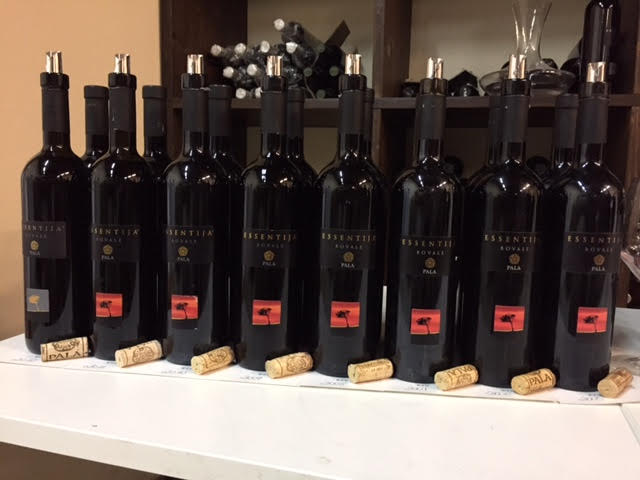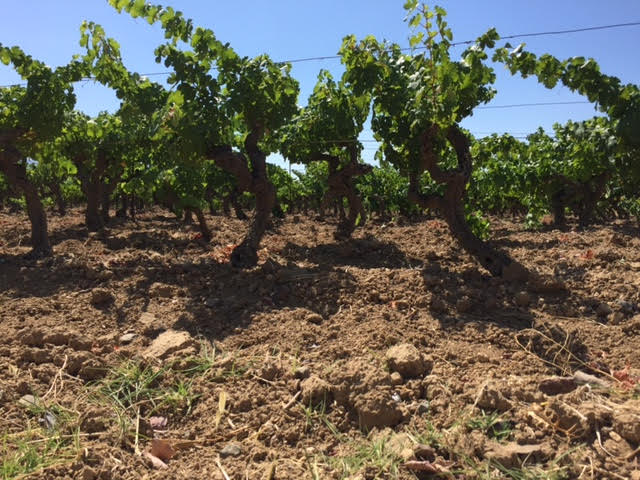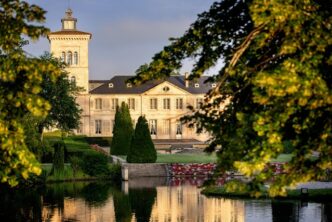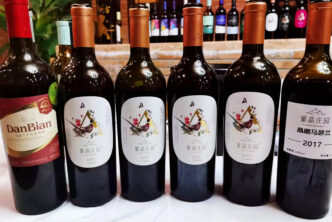The Pala estate in Sardinia was officially born in 1950, the first year in which the family headed by Salvatore Pala released an estate-bottled wine for sale (but in fact ancestor Battistino Sala was making wine and selling it already at the beginning of the 1900s). However, it was in 1950 that the Pala winery stepped into the modern age, or when Salvatore decided to bottle a white wine with the local Nuragus grape and a red wine that was a blend of the just as local varieties Monica and Pascale (I can’t even begin to make you understand just how good the wines from those three varieties can be). That focus, energy and attention to Italy’s, or rather Sardinia’s, native grapes has continued unabated ever since, meaning that Pala has always grown and bottled wines from native grapes. Still today, the winery represents one of the island’s best sources of Nuragus, Vermentino, Cannonau, Carignano, Bovale Grande, Nasco and Monica wines. Currently the estate is run by Mario Pala and his wife Rita, plus their children Massimiliano, Elisabetta and Mariaantonietta (Elisabetta has created her own line of wines, called Mora&Memo, and they are absolutely excellent, so look for them as well). Quality at the estate has never waned, but the estate’s name has changed ever so slightly over the years: it was initially modified to Fratelli Pala from Pala Salvatore when Salvatore stepped down in 1995, leaving his three children Mario, Gilberto and Enrico in charge. And then, in 2009, when Mario remained the only one of the siblings to want to stay in the wine business, the winery changed name once again, becoming Azienda Agricola Pala di Mario Pala, or more simply, just Pala.

I have been follwing the wines of this estate closely for twenty years now (you have to, if you really want to learn anything about Nuragus, the Bovales, the Monicas and other local grapes), and can safely say the estate has gone from strength to strength. Mario Pala, a really passionate and driven Italian vignaiolo and wine producer (and I have met a few), is strongly attached to Nuragus and Monica especially, but to all his native grapes, and is helped out not just by his family but by an outstanding general director, Fabio Angius, truly one of the brightest, most passionate and knowledgeable wine minds in Italy. The winery now exports about 60% of its production. Located in the small town of Serdiana about twenty kilometrs north of Cagliari, the winery produces over 600,000 bottles a year from one hundred hectares spread out over five different vineyard zones. It bears noting that Pala’s youngest vines would easily be amongst the oldest of over 80% of the world’s wine estates. In 2010, when Mario began to fly solo, he decided to revamp the whole production, thereby creating two lines of wines: the “I Fiori” selections, made from the estate’s youngest vines (forty years old on average, so youth is very much in the eye of the beholder here), and the “Cru” selections, where vine age can border on the almost ridiculous (on average anywhere from forty to as much as 120 years of age).
The area is exceptionally beautiful and well worth a visit. The winery itself is very welcoming and pretty, and looks like a typical Mediterranean home (just the sort of house you’d expect anywhere in Spain or southern Italy, but the building is actually not a mere generic Mediterranean edifice; rather, it represents accurately the typical constructions of the area of Serdiana, the town where Pala is located). Besides the winery, I suggest you visit the local specialty food shops for authentic Sardinian meat and pressed mullet roe products (bottarga di muggine: please: not tuna, the real experts know much better) that you can eat back in your hotel room while cracking open a good bottle of Nuragus, Semidano or Monica. And if you have time and can steal away from all the winery vists, make sure you get to the Santa Maria di Sibiola church, a Romanic period edifice that is well worth the visit, the eighteenth century Castello Roberti, as well as the “Staini Saliu” a small saltwater lake, plus other local simialr pons and small lakes/lagoons too, where, if you are lucky, and you happen to be vsiting in winter, you will catch sight of more than one pink flamingo.
Bovale Grande, the grape variety, and setting the record straight
Most people have no clue as to what Bovale is. Or of what its wines taste like. Which of course is more than reasonable, given that “Bovale” as such does not exist. Just like there are Cabernet Franc and Cabernet Sauvignon, that everybody who loves wine knows full well are different grape varieties and that give wholly different wines, so there are two different Bovale varieties. The two Bovale varieties are Bovale Grande and Bovale Sardo, that, like the two Cabernets, boast different morphologies and behaviours. And perhaps more importantly for those who like to drink wine and not just study it, their wines are also completely different.

Bovale Sardo is the “true” Sardinian Bovale that was for a while mistakenly identified with Graciano, one of the almost innumerable mistakes made in the realm of ampelographic identification thoughout the last two centuries. Unfortunately, these mistakes are all over the websites and in books that copy from each other. It is commonly written that Bovale Sardo, Graciano and Cagnulari are the same variety, but that is, plain and simple, wrong. As I documented extensively in Native Wine Grapes of Italy (2014), there is clear-cut evidence showing genetic differences between these three varieties in studies dating back already to 2010 and 2011, so continuing to cite just one older study makes little academic and scientific sense (actually doing the research and actually reading the scientific papers might be a good idea, rather than just conveniently copying what other books and websites are getting wrong). Undoubtedly, Bovale Sardo does resemble Graciano to a degree, but the DNAs of the two varieties have been shown to differ and so they cannot be considered to be identical grapevines. Perhaps Graciano was brought over to Sardinia during the period of Spanish domination, and over the centuries it adapted by mutating to its new Sardinian habitat (so if anything, it is a Sardinian biotype of Graciano that looks and expresses itself differently from the Spanish variety), but at the present state of scientific knowledge, that is speculation too. In any case, it appears that Bovale Sardo has been hanging around Sardinian shores for quite some time: keep in mind that Mario Pala and Fabio Angus have both told me over the years that in the forests of Monte Arci and Gennargentu people have found centenary old wild Bovale Sardo plants. By contrast, Bovale Grande may really be a Spanish variety, Mazuelo (Carignan), though those two also have enough morphologic and behavioural differences to make you wonder. To be sure, really old vines of Bovale Grande look very different from Mazuelo, while the vines planted in the last twenty eyars or so really are all probably Mazuelo since nurseris delivered Mazuelo when asked for Bovale Grande (thinking, in good fath, the two varieties were one and the same). Last but not least, the two Bovale wine grapes don’t look anything like each other (for example, Bovale Grande has much larger berries and stockier bunches; it’s also a much rarer variety on the island).
Bovale Sardo is a grape variety the Pala family is especially attached to, especially their director Angius whose grandfather was already making wine from Bovale Sardo in his time. Bovale Sardo’s bunch is fairly compact, so rainy weather is a no-no; fortunately, as it grows in sandy-rich soils where drainage is excellent, at least stagnant soil water does not pose a problem. It’s not very productive, and so grape crops are on the small side: for this reason, in local parlance and dialect, Bovale Sardo is nicknamed Bovabi Mascu (male), in a node to its naturally low productivity (fertility).

The wines are fairly dark in colour, though they are never as black-tinted as those of Merlot or Cabernet Sauvignon might be. However, Bovale Sardo does give some of Italy’s most tannic, structured and high acid red wines: total acidities of 7-8 g/L in the wines are not uncommon (though with climate change they appear to have stabilized at around 6.5 g/L) while all other Sardinian red wines rarely exceed 5.5g/L naturally). That acid motherlode makes the Bovale Sardo’s tannic heft, which is considerable, stand out even more. Some producers on the island purposely partly air-dry the Bovale Sardo grapes on the vine to beat its tannic clout into submission; others cut the wine historically with grapes that gave lighter wines (much like Canaiolo Nero in Tuscany with Sangiovese and the Malvasia Neras with Negro Amaro in Puglia). At Pala they give us a pure, unadulterated version of this wine.
The Bovale Sardo vineyard land
Essentija is the first ever monovariety Bovale Grande wine made in Sardinia, and if it being a great, ageworthy red wine is not enough for you, then that bit of history helps give this wine even more importance than it already has and deserves. Pala have farmed and bought Bovale Sardo vineyards for decades: the roughly four hectares that make up the original Essentija vineyard was bought in 2003. Just imagine that the vines were already then as much as 126 years old, and they are, still today, some of the island’s oldest grapevines. Besides vines in the Terralba portion of Sardinia (at the feet of Mount Arci in the central-western part of Sardinia’s territory, just below the area in which the famous Vernaccia di Oristano is made), Bovale Sardo grapes are also sourced from Uras and San Nicolò Arcidano. Essentija is essentially made from plots in these three area that are less than two kilometers from each other, planted to 7500 plants per hectare and tightly spaced (because these old vineyards were meant to be worked by horses, not tractors). The vines of the three parcels range from fifty to one hundred and thirty years of age, depending on the plot, but those used to make Essentija are mostly centenerian (from 113-127 years of age). The area is characterized by very pure white-coloured sandy soil, but differently from Terralba (which means “lands of the dawn”, as in “white lands”, a reference to the pale dawn light), in Uras (especially) and San Nicolò Arcidano the sand rests on a deep layer of volcanic soil (the latter does not really play much of a role: the area is characterized by its presence of sand). Given their age and highly sandy soil they are planted in, the vines are ungrafted (phylloxera can’t survive on the highly sandy soils typical of the lower Oristanese). The vineyards lie at only eleven or so meters above sea level, and in fact the sea is very close, only four kilometers away. It’s the traditional area of the island in which to make Bovale Sardo: should you be so lucky to walk there, a truly beautiful landscape awaits you one in which you will see the grapevine plots share space with cacti and sand dunes.
Bovale Sardo, the wine: Essentija.
The must is kept on the skins at controlled temperature with the addition of yeasts selected in the Pala vineyards (using native yeats with Bovale Sardo is extremely difficult becase of the variety’s penchant for reductivity during the winemaking process), and lasts about eight to ten days. After the maceration, the fermentation continues in stainless steel vats at controlled temperature of about 22/24 degrees Celsius. Light clarifications are carried out and the wine aged in underground cement-inox tanks for about four months and then continues in new 1000 liter French oak barrels for two years. The wine goes on sale after another couple of months spent resting in stainless steel and bottle. As many as 9,000 bottles a year have been made in good years. But production is highly variable: for example it was 3800 in 2017, none in 2018, and 4200 in 2019. Unfortunately devastating spring frosts have lately taken their toll on the area. The first vintage iof Essentija ever made is the 2003 (that the estate is sold out of). The wine is always a bit on the wild side (that reductive character again), and reminds me of, but only when it is open from prolonged aeration (decanting 24 hours ahead is actually a good idea) forest floor, licorice, tar, figs amcerated in alcohol, smoke, camphor, musk, plums and prunes, and both red and dark berries. Interestingly, as tannic as Bovale Sardo’s wines can be, this tasting clearly shows that they smoothen out over time and the wines are smooth and lovely to drink about eight to ten years after the vintage, but will last for much longer.

The wines in this tasting report
Pala 2019 Bovale Isola dei Nuraghi Essentija 92
Opaque deep ruby. Restrained but pure aromas of black plum, licorice, violet, camphor, mocha and peppery herbs. Dense, sappy and concentrated, boasting musky dark berry flavours nicely complemented by peppery spices. Classic, satisfying and complete Bovale Sardo wine, with a slightly more luscious, rounder texture than is usual. Closes long, with excellent breadth and youthfully chewy tannins and repeating notes of licorice, camphor and violet. Strikes me as one of the longest Essentijas ever. Drinking window: 2026-2034.
Pala 2016 Bovale Isola dei Nuraghi Essentija 91
Bright, moderately saturated ruby. Ripe aromas and flavours of blackberry, balsamic oils and licorice complicated by a musky quality. Big and rich, with a saline tinge to the long finish, with strong, dusty tannins and excellent length. Drinking window: 2025-2032.
Pala 2015 Bovale Isola dei Nuraghi Essentija 95
Good full inky-ruby. Cherries amcerated in port, dried figs, tar, graphite, and pot-pourri on the expressive, showy nose. Multilayered and concentrated, with a steely core of acidity that really extends the flavours on the seamless finish. This Essentija is a little on the warm side (the octanes show on the close) and big but still fresh and relatively light on its feet. A classic wine that has filled out impressively since I last tasted this vintage a few years ago, but that has always been one of the best, if not perhaps the best Essentija ever. Drinking window: 2024-2032.
Pala 2013 Bovale Isola dei Nuraghi Essentija 91
Bright saturated deep ruby. Perfumed aromas of dark fruits, pink peppercorn, tar, field herbs and minerals. Enters fairly pliant and smooth, with very good inner-mouth floral to its plum, dark berry licorice, and balsamic oil flavours. The aftertaste is lively and penetrating, and not at all overripe, with broad, polished tannins and noteworthy length. Drinking window: 2022-2030.
Pala 2012 Bovale Isola dei Nuraghi Essentija 93
Deep ruby. Refined nose of floral strawberry, chocolate and sweet brown spices, complicated by earth and truffle tones. Big but also quite soft and round (for a Bovale Sardo wine, that’s quite the feat!), with smooth chcololaty flavours of red fruit and dark plums. Finishes with a soft peppery note and juicy floral and orchard fruit elements and a really enticing hint of chocolate-covered cherries. Reports 14% alcohol, but this doesn’t taste at all as if it has those octanes. The 2012 vintage was probably saved by the fact that though things started out way too hot, by August on the average daily temperatures cooled down. Aged in about in 25% new French oak barrels. Drinking window: 2022-2028.
Pala 2011 Bovale Isola dei Nuraghi Essentija 94
Deep red-ruby. Red cherry, tobacco, minerals and chocolate on the complex nose. Then dense and multilayered with very deep, suave flavours of red cherry, sweet spices, botanical herbs and minerals. Long and clean, this is an outstanding Bovale Sardo. 14% alcohol. The 2011 vintage in the area turned out to be much better for red wines than the whites (it was too hot for white grapes, especially in August). Drinking window: 2022-2030.
Pala 2010 Bovale Isola dei Nuraghi Essentija 95
Deep ruby. Almost aromatic on the nose (now this is a little bit like Graciano!), with extremely perfumed red cherry and raspberry jelly nuances complicating red rose, spicy earth tones and herbal aromas and flavours. Bright and juicy from start to finish, boasting a very pure, precise mouthfeel. The clean, caper- and eucalyptus-accented finish is refreshingly saline. The 2010 vintage here was a great year of very balanced wines, and it shows. Drinking window: 2022-2035.
Pala 2009 Bovale Isola dei Nuraghi Essentija 92
Medium deep ruby. Aromas of oregano, thyme and coriander complement red cherry and plum, all lifted by a bright red rose note that builds with aeration. Bright, juicy and fresh, with a saline note of underbrush complicating strawberry and tobacco notes. Finishes bright and juicy, with really lovely floral and balsamic herbs, not to mention an explosive spiciness. One of the rainiest vintages on record, but I’d say this is a gem. Drinking window: 2022-2028.
Pala 2008 Bovale Isola dei Nuraghi Essentija
Deep ruby with a red rim. Slightly earthy nuances to the aromas and flavours of red cherry, plum and coffee. A very refined and smooth Bovale Sardo wine, with an enticing chocolaty, herbal and spicy finish. A very hot year in the area, but this wine is marvelously well-balanced with no signs of overripeness or of gritty tannins. Drinking window: 2022-2030.
Pala 2007 Bovale Isola dei Nuraghi Essentija 90
Beef broth and umami on the nose, then very dense, with perfumed sweet plum, candied violet and leather flavours that linger nicely. Starts out soft and suave, but there’s a rising hint of grittiness on the long back end; with this wine, you can tell it was a hot year, but I need to tell you that, despite what I think or thought, at Pala they didn’t feel 2007 was that warm after all over in the Serdiana area. They view it as a very good vintage. Drinking window: 2022-2030.
Pala 2006 Bovale Isola dei Nuraghi Essentija 93
Dark ruby. Very perfumed, downright fragrant red fruit and herbs on the inviting nose, complicated by violet and camphor. Then very refined flavours of ripe red cherry and licorice, with a mineral edge that adds complexity. Closes very long elegant with a suave mouthfeel for a wine made wirth Bovale Sardo, this is remarklably light on its feet. The 2006 vinatge ran more or less smoothlya nd was quite simialr to the 2005, maybe just a little warmer, but you really can’t tell from drinkin g this gorgeous wine. Drinking window: 2022-2032.
Pala 2005 Bovale Isola dei Nuraghi Essentija 93
Deep ruby. Inviting, very intense blueberry and plum notes on the nose and in the mouth; with aeration, hints of black cherry, balsamic vinegar, milk chocolate, and mocha emerge, with suggestions of mint and dried berries. Full and very ripe but not heavy, this finishes very long with lovely sappy depth and pliancy. The presence of the oak here is hardly discernible. The 2005 vintage was a very good one that gave very balanced year (it was good for whites as well). Drinking window: 2022-2033.

 English
English



